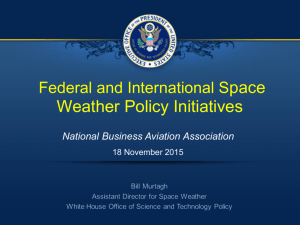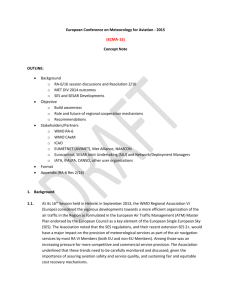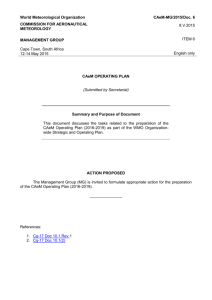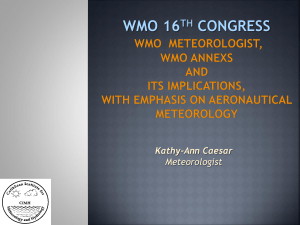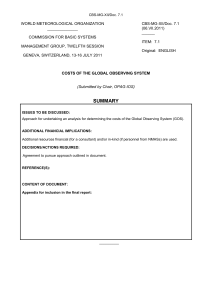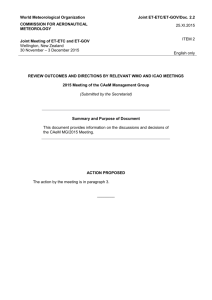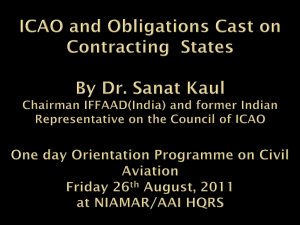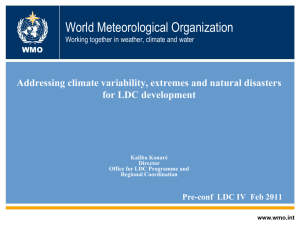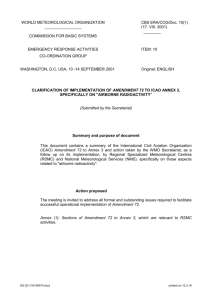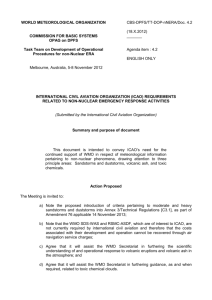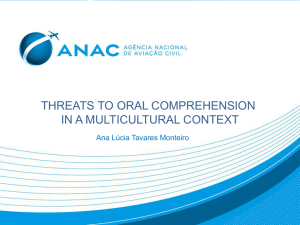Memo 31 Appendix
advertisement
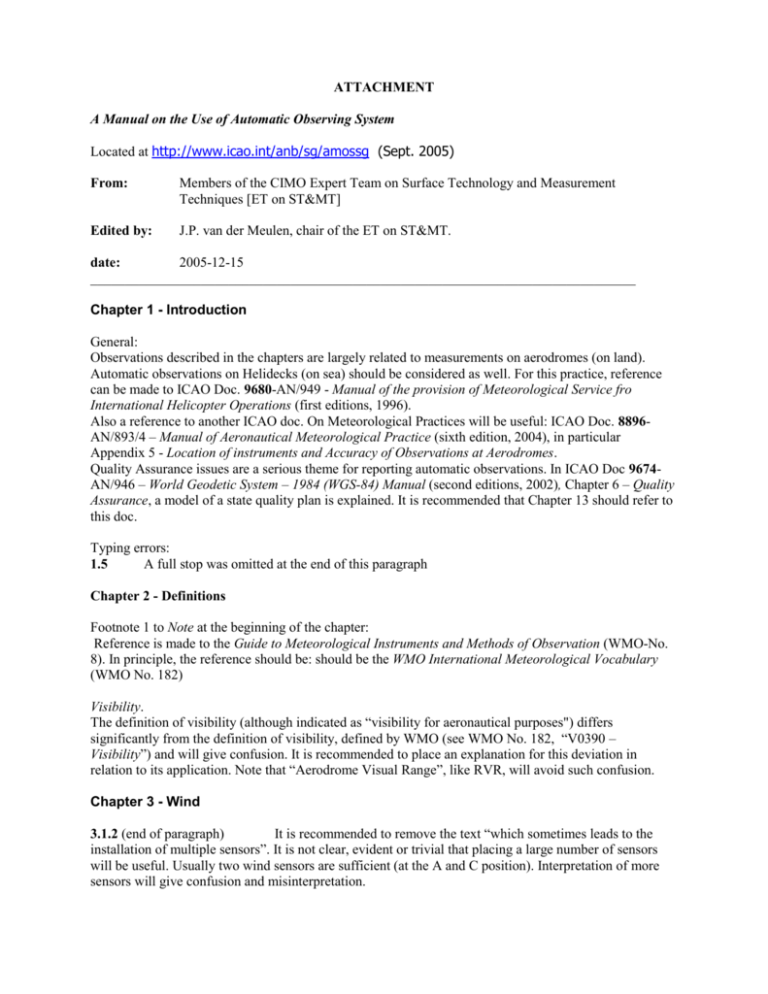
ATTACHMENT A Manual on the Use of Automatic Observing System Located at http://www.icao.int/anb/sg/amossg (Sept. 2005) From: Members of the CIMO Expert Team on Surface Technology and Measurement Techniques [ET on ST&MT] Edited by: J.P. van der Meulen, chair of the ET on ST&MT. date: 2005-12-15 _______________________________________________________________________________ Chapter 1 - Introduction General: Observations described in the chapters are largely related to measurements on aerodromes (on land). Automatic observations on Helidecks (on sea) should be considered as well. For this practice, reference can be made to ICAO Doc. 9680-AN/949 - Manual of the provision of Meteorological Service fro International Helicopter Operations (first editions, 1996). Also a reference to another ICAO doc. On Meteorological Practices will be useful: ICAO Doc. 8896AN/893/4 – Manual of Aeronautical Meteorological Practice (sixth edition, 2004), in particular Appendix 5 - Location of instruments and Accuracy of Observations at Aerodromes. Quality Assurance issues are a serious theme for reporting automatic observations. In ICAO Doc 9674AN/946 – World Geodetic System – 1984 (WGS-84) Manual (second editions, 2002), Chapter 6 – Quality Assurance, a model of a state quality plan is explained. It is recommended that Chapter 13 should refer to this doc. Typing errors: 1.5 A full stop was omitted at the end of this paragraph Chapter 2 - Definitions Footnote 1 to Note at the beginning of the chapter: Reference is made to the Guide to Meteorological Instruments and Methods of Observation (WMO-No. 8). In principle, the reference should be: should be the WMO International Meteorological Vocabulary (WMO No. 182) Visibility. The definition of visibility (although indicated as “visibility for aeronautical purposes") differs significantly from the definition of visibility, defined by WMO (see WMO No. 182, “V0390 – Visibility”) and will give confusion. It is recommended to place an explanation for this deviation in relation to its application. Note that “Aerodrome Visual Range”, like RVR, will avoid such confusion. Chapter 3 - Wind 3.1.2 (end of paragraph) It is recommended to remove the text “which sometimes leads to the installation of multiple sensors”. It is not clear, evident or trivial that placing a large number of sensors will be useful. Usually two wind sensors are sufficient (at the A and C position). Interpretation of more sensors will give confusion and misinterpretation. -2 3.2.1 It is not recommended to use the word ‘time value’ instead of ‘time constant’, because such ‘constant’ depends on the wind speed and is, as a result, not a constant. 3.2.2 A short description of hot-wire and ultrasonic sensors is found useful. 3.3.1 It is recommended to provide an explanation why mean values should be used and not instantaneous values. 3.3.1.4 The statement that no calculation method is recommended in not correct. The method is stated in Part III of the WMO Guide to Instruments and Methods of Observations (the use of scalars is recommended). 3.3.2.1 The calculus of an average (or mean) vectors from scalars can be performed by simple vector algebra or goniometry. The explanation given in this paragraph introduces complexity and confusion. It is recommended to explain the issue in very short terms. 3.4.2 Reference to ICAO Doc. 8896, App. 5 (Location of Instruments and Accuracy of Observations at Aerodromes) is found useful here. That doc. also indicates carefulness for typical impacts like artificial wind vortexes. Chapter 4 - Visibility 4.1.2 It is recommended to explain the background of this definition related to two parameters and why it differs from the common definition of visibility. 4.2.1 It is recommended to repeat in line with Annex 3, the statement (note) that a scatter meter should be calibrated with respect to a transmissometer, which is declared as national standard. 4.2.4. To measure MOR values of 10 km with a transmissometer, a baseline of about 250 m should be used to meet the required measurement uncertainty. It is doubtful if such a distance will be feasible in operational practice. For such measurements at least three baselines should be used. Therefore the statement that “double-base transmissometers make it possible to cover a greater range of measurement” will give confusion here. Such double-baseline transmissometers cover the range up to about 3000 m at maximum (see both ICAO Docs. 8896 and 9328, with stated recommendations on the use of transmissometers) Chapter 6 - Present Weather 6.1 It is suggested to indicate in some detail the typical present weather parameters and phenomena to be observed at the aerodrome. This will be useful to avoid some confusion when reading par. 6.2. 6.4.6.1 (second line). The statement that a defined detection threshold does not exist is not correct (see also 6.4.6.2). WMO has adopted the statement that (liquid) precipitation should be detected for intensities larger that 0.02 mm/h (as ‘trace’ up to 0.2 mm/h), based on an averaging period of one minute (not 10 min as stated in 6.4.6.2). WMO recommends that for intensities larger than 0.2 mm/h a (measured) quantitative value should be reported (and not a qualitative subjective parameter like ‘light, moderate or heavy’). Reference can be made to the WMO Guide to Meteorological Instruments and Methods of Observation (7th edition). 6.4.16 If liquid precipitation will freeze depends on both the air temperature and the adiabatic saturation temperature, which is close to the so-called wet bulb temperature. Using a simple relation -3 containing both variables ‘freezing’ can be identified, also for air temperatures above freezing point. 6.5 It is recommended to explain why some present weather parameters or phenomena are difficult to identify. Chapter 7 – Clouds 7.4.2.1 Although vertical visibility might be not so well defined in Annex3, it is defined by WMO (see WMO No. 182, ‘V0280 – Vertical Visibility: Maximum distance at which an observer can see and identify an object on the same vertical as himself, above or below). It is stated that observations of vertical visibility will not only be done upwards, but also downwards, like from a helideck offshore. It is recommended to add some text in line with this statement. 7.4.2.4 Using a LIDAR ceilometer as a scatter meter, measuring the backscatter profile, the extinction can be measured as a function of place and a ‘vertical optical range’ as a result. In practice, the technology used by such a ceilometer should be capable enough to provide vertical visibility. From that point of view both paragraphs 7.4.2.3 (human observations) and 7.4.2.4 can be rephrased accordingly. (Note that 7.4.2.3 deals with human observations, which might be not applicable for this manual) Chapter 8 - Air temperature and dew point temperature 8.2.2.1 Typing error: The unit of resistance is presented as “O” not “” (ohm). It is noted that an Pt100 sensor will suffer from self heating (more than the required uncertainty of 0.1 C) for low wind speeds. Therefore Pt elements with a larger resistance are recommended (like Pt1000). 8.2.3.3 It is not clear why the measurement uncertainty of a RH measurement is 5% to 6% RH. The WMO Guide to Meteorological Instruments and Observing Practices states that the required measurement uncertainty for RH measurements is 1% (currently attainable uncertainty 3%). For T-dew measurements the required uncertainty is 0.1 K (currently attainable uncertainty 0.5 K) (see also 8.2.4.4) 8.2.5.3 The statement that forced ventilated screens provides greater benefits than passive screens is found doubtful. For instance, in regions with much drizzle and precipitation the temperature sensors are forced to get wet and therefore act as wet-bulb thermometers instead of dry-bulb thermometers, introducing a negative bias. 8.3 It is recommended to indicate that the local environmental conditions on an airport or helideck may influence strongly the measurement (see also ICAO doc 8896). Especially the heating by the runway, surrounding constructions and exhaust of engines may have significant impact and care must be taken to avoid any impact. 8.4.3 Typing error in the last line: The degree sign should be added to the C (to become C) Chapter 9 – Pressure 9.2.2 The units used in the formulas should be indicated as well (feet, hPa?) and some more editing is recommended to avoid confusion. Moreover such formulas are only simple mathematics, not algorithms. 9.5.1 It is recommended not to state that ‘a barometer should be installed indoors’. It is proven that wind induced impact inside buildings will give an additional pressure value larger than the required measurement uncertainty, especially in cases with strong winds. In the WMO Guide to Meteorological Instruments and Observing Methods it is recommended to measure with an appropriate static tube with an outlet outside buildings and not influenced by pressure build-up due to such buildings. 9.5.3 The statement on the pressure port and possible obstructions is found rather subjective. It is suggested that a more general and objective statement should be given. -4 Chapter 13 – Quality Assurance See under Chapter 1, “general”, with recommendation to refer to ICAO Doc 9647, Chapter 6 - Quality Assurance. Appendix A – Algorithms Because in this appendix the methods of calculus is presented as examples only some remarks are given: some variables are not clearly specified some stop criteria are not well explained in a number of cases observations are modified within the observing system and based on empirical relations (e.g. snow will become rain if the air temperature is above 5 C). Such modifications should improve the performance of such a systems. However, great care should be taken to avoid filtering out special phenomena, which are correctly observed and relevant for the meteorological service. Appendix B – Bibliography It is recommended to add the ICAO docs, mentioned above (see under Chapter 1), i.e. the ICAO docs. 9680 (on helidecks), 8896 (on siting of instruments at aerodromes) and 9674 (on quality assurance).
